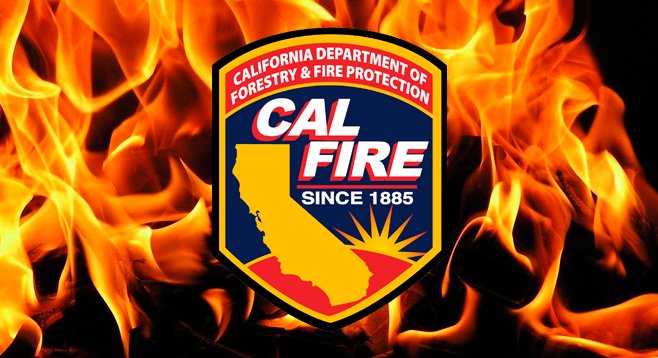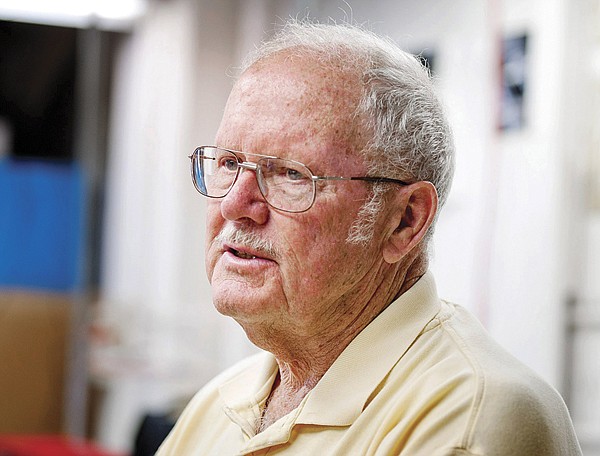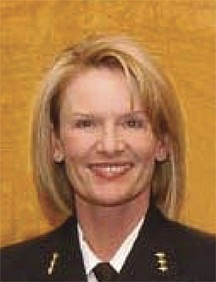 Facebook
Facebook
 X
X
 Instagram
Instagram
 TikTok
TikTok
 Youtube
Youtube

The bills will go out in the high noon of fire season. Starting in August, they will be sent to rural mailboxes where Cal Fire has primary responsibility for firefighting, although local fire districts often overlap.
For owners of multiple dwellings, such as properties with granny flats, the tab will quickly climb. California State Assembly Bill x1 29, enacted last July, calls for a new annual “fire prevention benefit fee” of up to $150 per “habitable structure,” to be charged property owners in “state responsibility areas.”
In San Diego County, an estimated 73,000 homes will be affected.
As the argument goes, Cal Fire provides both private benefits, such as protecting homes and timberlands, and public benefits, such as protecting watersheds.
Who benefits the most?
According to the bill, fire prevention services “specifically benefit” rural property owners. Their homes are at risk of igniting, which can also damage state wildlands and hinder firefighting. So homeowners in far-flung areas of the county, where some move to escape the high cost of city housing, will pay to reflect their share of Cal Fire costs.
The bill allows a $35 reduction per structure for those in a local fire protection district, which includes most of the buildings affected by the fee.
The funds will support various grants to Fire Safe Councils, California Conservation Corps, and others for fire prevention projects, public education, and fire hazard mapping. Cal Fire also hired additional inspectors to help residents comply with county brush-clearing ordinances.
Ron Peterka, a former member of the board of directors with Intermountain Fire & Rescue Department, calls the fee an unfair “tax.” He thinks it will harm groups such as Intermountain, which serves almost 125 square miles of country east of Ramona. “As a volunteer operation, we get very little financial support from the County,” he says. Any additional aid could keep them solvent.

But such aid may not be offered when residents he describes as “mostly low income” must pay the new fee in addition to any support they may give to Intermountain. “It will directly affect our fundraising because many residents will assume fire prevention is synonymous with fire protection.”
Cal Fire’s original mission was to fight wildfires in undeveloped areas. But according to a 2009 state budget analysis, rural housing development led to “mission creep.” Now the department spends “considerable time and resources protecting homes” from wildfire. Other emergency calls unrelated to wildfires add to the burden.
The Regional Council of Rural Counties calls the fees “grossly inequitable” to rural residents and claims that it costs far more to address emergencies in urban areas than to fight traditional wildfires. The council contends that it requires more resources to fight fires “on the outskirts of the City of San Diego than it does in any portion of Trinity County,” a heavily forested, thinly populated county in Northern California.
Peterka admits that residential expansion has caused more need for fire and emergency services in San Diego’s backcountry. But a fee restricted to fire prevention isn’t “an effective use of critical funds,” he says. The money “can’t be used to prop up any existing fire protection.”
It won’t, for example, mean hiring firefighters or purchasing firefighting equipment.
Major fires have increased, “but no possible fire prevention service would have prevented either the Cedar or Witch fires,” he says, referring to two massive fires that devastated large portions of the county in 2003 and 2007. Intermountain volunteers were the first responders to battle the Witch Creek fire, which broke out near Ramona.
Since then, backcountry firefighting has only gotten costlier. The state’s largest general-fund expenditure in the natural resources area is for fire protection.
Yet previous bills to pass similar fees for fire protection have gone nowhere.
In 2003, the legislature enacted SB 1049, imposing an annual $35 fire protection fee on parcels of land in state responsibility areas. The fee was to be collected by counties for fire prevention and suppression by Cal Fire. But in 2004, before it was ever collected, the law was repealed due to concerns about the inequity of a flat fee. That is, the owner of a small parcel would pay the same amount as the owner of a large parcel, even though protecting the larger plot would cost more.
In 2007, the legislative analyst’s office recommended imposing a fire protection fee on rural property owners “so that the beneficiaries of state fire protection pay a portion of their costs.”
In 2008 and 2009, such bills were shot down.
The current fee will generate an estimated $84.4 million annually, according to Cal Fire, which had $50 million cut from its budget for 2011–12. San Diego County residents are expected to contribute about $10 million.
The Glendora-based nonprofit California Fire Safe Council, whose mission is to mobilize residents to protect their homes and communities from wildfire, supports the fee and its focus on fire prevention. “I take a much longer view,” says board member Kate Dargan, who is a retired California state fire marshal and a 30-year Cal Fire veteran. “We know that mitigation is very effective.” Post-fire damage assessments have shown that “homes with defensible space survive much better,” she says.

Dargan thinks rural property owners should foot the bill. Asked if she thinks the fee may harm local groups like Intermountain, she answers, “That’s an issue.” In a recent letter sent to legislators, the council urged a different allocation of funds, giving 25 percent directly to local fire protection districts.
The letter made recommendations the council says will help “lead a national example of how to utilize limited funds as effectively as possible.”
But the fee has sparked so much controversy, the California Board of Forestry and Fire Protection held two meetings in May to receive public comment before adopting a permanent regulation.
The first meeting, held May 16 in San Diego, was attended by about three-dozen people. Among them was Supervisor Dianne Jacob, who thinks the fee unfairly targets rural property owners to make up for the state’s inability to balance the budget. Jacob wants a countywide exemption of the fee.
Peterka didn’t attend the meeting. “I think there is next to no way local response would change the path of this fee,” he says.
Opponents still see a small window to overturn the law. Although AB 1506, which would have repealed it, has failed, Dargan says lawsuits may follow after the first bills go out. The key issue: is the charge a tax or a benefit fee?
“We agree the law should be tested,” Dargan says, to ensure that homeowners are receiving a real benefit from the services.
Meanwhile, as some anxiously check to see if they live in a state responsibility area, the U.S. Climate Prediction Center has published a map that won’t have rural residents resting easier.
It predicts that a significant wildfire season is developing in the Southwest.
For a map of state responsibility areas: bof.fire.ca.gov/sra_viewer/. ■


The bills will go out in the high noon of fire season. Starting in August, they will be sent to rural mailboxes where Cal Fire has primary responsibility for firefighting, although local fire districts often overlap.
For owners of multiple dwellings, such as properties with granny flats, the tab will quickly climb. California State Assembly Bill x1 29, enacted last July, calls for a new annual “fire prevention benefit fee” of up to $150 per “habitable structure,” to be charged property owners in “state responsibility areas.”
In San Diego County, an estimated 73,000 homes will be affected.
As the argument goes, Cal Fire provides both private benefits, such as protecting homes and timberlands, and public benefits, such as protecting watersheds.
Who benefits the most?
According to the bill, fire prevention services “specifically benefit” rural property owners. Their homes are at risk of igniting, which can also damage state wildlands and hinder firefighting. So homeowners in far-flung areas of the county, where some move to escape the high cost of city housing, will pay to reflect their share of Cal Fire costs.
The bill allows a $35 reduction per structure for those in a local fire protection district, which includes most of the buildings affected by the fee.
The funds will support various grants to Fire Safe Councils, California Conservation Corps, and others for fire prevention projects, public education, and fire hazard mapping. Cal Fire also hired additional inspectors to help residents comply with county brush-clearing ordinances.
Ron Peterka, a former member of the board of directors with Intermountain Fire & Rescue Department, calls the fee an unfair “tax.” He thinks it will harm groups such as Intermountain, which serves almost 125 square miles of country east of Ramona. “As a volunteer operation, we get very little financial support from the County,” he says. Any additional aid could keep them solvent.

But such aid may not be offered when residents he describes as “mostly low income” must pay the new fee in addition to any support they may give to Intermountain. “It will directly affect our fundraising because many residents will assume fire prevention is synonymous with fire protection.”
Cal Fire’s original mission was to fight wildfires in undeveloped areas. But according to a 2009 state budget analysis, rural housing development led to “mission creep.” Now the department spends “considerable time and resources protecting homes” from wildfire. Other emergency calls unrelated to wildfires add to the burden.
The Regional Council of Rural Counties calls the fees “grossly inequitable” to rural residents and claims that it costs far more to address emergencies in urban areas than to fight traditional wildfires. The council contends that it requires more resources to fight fires “on the outskirts of the City of San Diego than it does in any portion of Trinity County,” a heavily forested, thinly populated county in Northern California.
Peterka admits that residential expansion has caused more need for fire and emergency services in San Diego’s backcountry. But a fee restricted to fire prevention isn’t “an effective use of critical funds,” he says. The money “can’t be used to prop up any existing fire protection.”
It won’t, for example, mean hiring firefighters or purchasing firefighting equipment.
Major fires have increased, “but no possible fire prevention service would have prevented either the Cedar or Witch fires,” he says, referring to two massive fires that devastated large portions of the county in 2003 and 2007. Intermountain volunteers were the first responders to battle the Witch Creek fire, which broke out near Ramona.
Since then, backcountry firefighting has only gotten costlier. The state’s largest general-fund expenditure in the natural resources area is for fire protection.
Yet previous bills to pass similar fees for fire protection have gone nowhere.
In 2003, the legislature enacted SB 1049, imposing an annual $35 fire protection fee on parcels of land in state responsibility areas. The fee was to be collected by counties for fire prevention and suppression by Cal Fire. But in 2004, before it was ever collected, the law was repealed due to concerns about the inequity of a flat fee. That is, the owner of a small parcel would pay the same amount as the owner of a large parcel, even though protecting the larger plot would cost more.
In 2007, the legislative analyst’s office recommended imposing a fire protection fee on rural property owners “so that the beneficiaries of state fire protection pay a portion of their costs.”
In 2008 and 2009, such bills were shot down.
The current fee will generate an estimated $84.4 million annually, according to Cal Fire, which had $50 million cut from its budget for 2011–12. San Diego County residents are expected to contribute about $10 million.
The Glendora-based nonprofit California Fire Safe Council, whose mission is to mobilize residents to protect their homes and communities from wildfire, supports the fee and its focus on fire prevention. “I take a much longer view,” says board member Kate Dargan, who is a retired California state fire marshal and a 30-year Cal Fire veteran. “We know that mitigation is very effective.” Post-fire damage assessments have shown that “homes with defensible space survive much better,” she says.

Dargan thinks rural property owners should foot the bill. Asked if she thinks the fee may harm local groups like Intermountain, she answers, “That’s an issue.” In a recent letter sent to legislators, the council urged a different allocation of funds, giving 25 percent directly to local fire protection districts.
The letter made recommendations the council says will help “lead a national example of how to utilize limited funds as effectively as possible.”
But the fee has sparked so much controversy, the California Board of Forestry and Fire Protection held two meetings in May to receive public comment before adopting a permanent regulation.
The first meeting, held May 16 in San Diego, was attended by about three-dozen people. Among them was Supervisor Dianne Jacob, who thinks the fee unfairly targets rural property owners to make up for the state’s inability to balance the budget. Jacob wants a countywide exemption of the fee.
Peterka didn’t attend the meeting. “I think there is next to no way local response would change the path of this fee,” he says.
Opponents still see a small window to overturn the law. Although AB 1506, which would have repealed it, has failed, Dargan says lawsuits may follow after the first bills go out. The key issue: is the charge a tax or a benefit fee?
“We agree the law should be tested,” Dargan says, to ensure that homeowners are receiving a real benefit from the services.
Meanwhile, as some anxiously check to see if they live in a state responsibility area, the U.S. Climate Prediction Center has published a map that won’t have rural residents resting easier.
It predicts that a significant wildfire season is developing in the Southwest.
For a map of state responsibility areas: bof.fire.ca.gov/sra_viewer/. ■
Comments